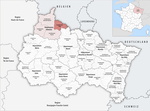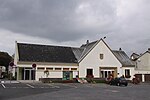Battle of Sedan

The Battle of Sedan was fought during the Franco-Prussian War from 1 to 2 September 1870. Resulting in the capture of Emperor Napoleon III and over a hundred thousand troops, it effectively decided the war in favour of Prussia and its allies, though fighting continued under a new French government. The 130,000 strong French Army of Châlons, commanded by Marshal Patrice de MacMahon and accompanied by Napoleon III, was attempting to lift the siege of Metz, only to be caught by the Prussian Fourth Army and defeated at the Battle of Beaumont on 30 August. Commanded by Generalfeldmarschall Helmuth von Moltke and accompanied by Prussian King Wilhelm I and Prussian Chancellor Otto von Bismarck, the Fourth Army and the Prussian Third Army encircled MacMahon's army at Sedan in a battle of annihilation. Marshal MacMahon was wounded during the attacks and command passed to General Auguste-Alexandre Ducrot, until assumed by General Emmanuel Félix de Wimpffen. Bombarded from all sides by German artillery and with all breakout attempts defeated, the French Army of Châlons capitulated on 2 September, with 104,000 men passing into German captivity along with 558 guns. Napoleon III was taken prisoner, while the French government in Paris continued the war and proclaimed a Government of National Defense on 4 September. The German armies besieged Paris on 19 September.
Excerpt from the Wikipedia article Battle of Sedan (License: CC BY-SA 3.0, Authors, Images).Battle of Sedan
Place Calonne, Sedan
Geographical coordinates (GPS) Address Nearby Places Show on map
Geographical coordinates (GPS)
| Latitude | Longitude |
|---|---|
| N 49.7 ° | E 4.9444444444444 ° |
Address
Pôle Culturel Danser
Place Calonne 2
08200 Sedan
Grand Est, France
Open on Google Maps








